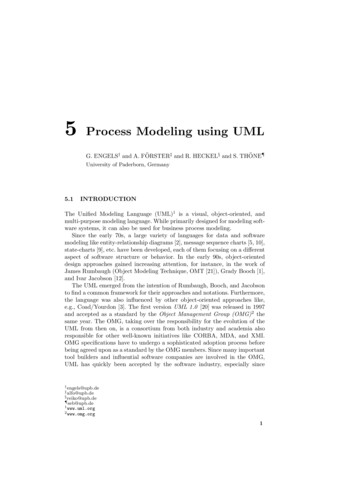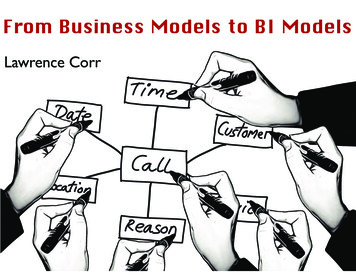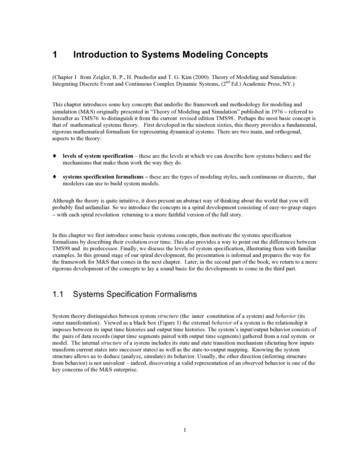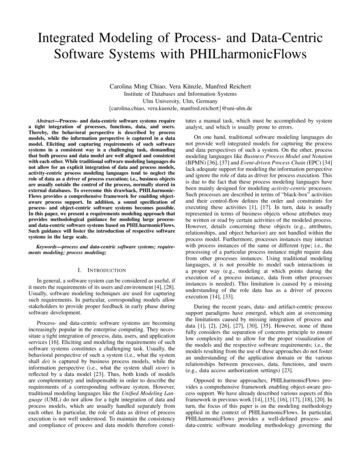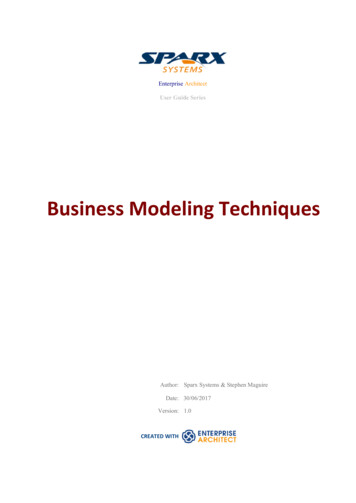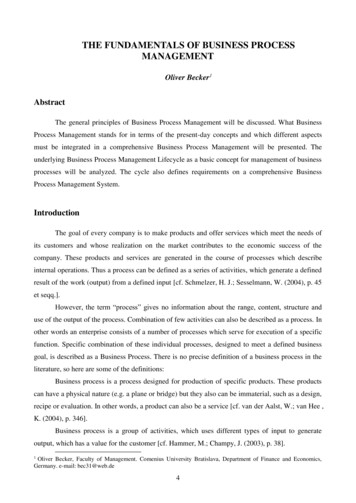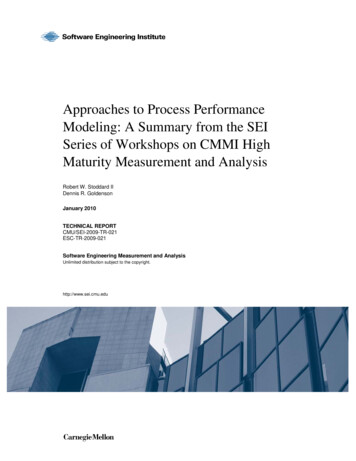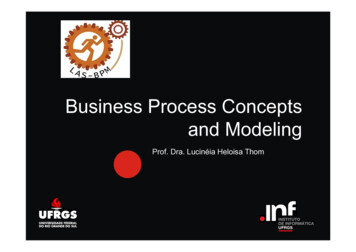
Transcription
Business Process Conceptsand ModelingProf. Dra. Lucinéia Heloisa ThomTítulo do capítulo
About myself Professional–– Academic––––––– Associate Professor at Informatics Institute of the Federal University of Rio Grandedo Sul (INF-UFRGS) since 2013Institutional Representative of INF-UFRGS at the Computer Brazilian SocietyPost-doc in Computer Science (UFRGS, Porto Alegre, Brasil, 2012)Post-doc in Computer Science (University Joseph Fourier, Grenoble, France, 2011)Post-doc in Computer Science (Ulm University, Germany, 2009)PhD in Computer Science (UFRGS, Porto Alegre, Brasil, 2006)PhD stage(Stuttgart University, Germany, 2005)Master in Computer Science (UFRGS, Porto Alegre, Brasil, 2002)Bachelor in Computer Science (UNISC, Santa Cruz do Sul, Brasil, 1999)Research Areas of Interest––––Business Process Management (BPM)Ontology and BPMInformation technology applied in HealthcareSoftware Engineering
Agenda Business Process Concepts and Modeling–––– Introduction to Business Process ManagementBasic Concepts in Business Process ManagementRequirements Elicitation in Process ModelingBusiness Process Modeling and NotationResearch Topics in Business Process Management––––Verification and Completness of BPMN Specification CodeOntology Building based on Process ModelsExtraction of Process Models based on Textual ProceduresBig Data classification based on Process Models
Business ProcessConcepts and ModelingIntroduction
Business Process are -orderApplication-to-approvalPayment
Business Process A set of one or more linked procedures oractivities which collectively realize a businessobjective or policy goal, normally within thecontext of an organizational structure definingfunctional roles and relationships (WfMC, 1999) A business process consists of a set of activitiesthat are performed in coordination in anorganizational and technical environment. Theseactivities jointly realize a business goal (Dumas,1998)A business process is as collection of interrelated events, activities and decision pointsthat involve a number of actors and objects, andthat collectively lead to an outcome that is ofvalue to at least one customer (Dumas, 2013)
Example of Business Processc] Fill theprescriptiona] Get information b] Calculate thedosage of theabout the patientdrugsd] Notify thefarmacy that anew drug needs tobe producede] Send theprescription tothe farmacyf] Verify thedosageg] Produce drugs
Business Process Management (BPM)Business Process Management is the art and science ofoverseeing how work is performed in an organization toensure consistent outcomes and to take advantage ofimprovement opportunities (Dumas et al 2013)BPM as a body ofmethods, techniques andtools to discover, analyze,redesign, execute and monitorbusiness processes8
Why BPM“The first rule of any technology used in a business isthat automation applied to an efficient operation willmagnify the efficiency.The second is that automation applied to an inefficientoperation will magnify the inefficiency.”To learn how to model and improve businessprocess rather than only to know how to buildinformation systems is a fundamental ability towhatever IT professional
Benefits of BPM Dynamic distribution of workWork monitoringApplications can be automatically invokedduring process executionStandardization of non-standardizedprocessesImprovement of process efficiencyReduction in time to complete workflows,and increase in their qualityReduction in human resourcesBetter ability to cope with and handlechanges to processesIncrease in the relevance of existing ITsystems within an organization
BPM Applications Aplications based on activity control and ordering canbe automatized by a WfMSIn Robotics, BPM and Workflow have been used tostandardize and document processes Healthcare processes that require dinamic adaptation andalso exception handlingE-learning E-science
BPM lifecycleDumas, 2013
Process IdentificationWhich process needto be improved? Which process presentoperational problems?Which are the limits of aprocess (start and end)?The complexity to answerthese questions is direcltyrelated to the process –oriented thinking existentin organizationsDumas, 2013
BPM LifecycleProcess Identification In case the organization already had a BPM initiative it ispossible that it has also process documentation– The process scope can be definedIn case there exists no BPM initiative, the BPM team must:– Identify the processes related to organizationalproblems– Demimitate the process scope– Identify relations between process (part-of-relations)Process Identification à Process Architecture
BPM LifecycleProcess Identification Estimate the value of a process execution is fundamental“YOU CANNOT CONTROL WHAT YOU ARE NOT ABLE TO ESTIMATE” (Tom DeMarco) Before analyze a process in details it is important to define clearmetrics to measure the process performance Costs metrics– Quantity of equipment's allocated in time spaceTime metrics– Time between an equipment request and its deliveryQuality metrics (error rates) Number of times a process finalize with undesirable result. E.g.an equipment is returned because it is not suitable
BPM LifecycleProcess Identification In this phase, a business problem is posed,processes relevant to the problem beingaddresses are identified, delimited andrelated to each other The outcome is a new or updated processarchitecture that provides an overall viewof the processes in an organization andtheir relationship
BPM LifecycleProcess Discovery Also called processmodellingThe current state of eachrelevant processes isdocumented, typically inthe form of one orseveral as-is processmodelWhy “ProcessDiscovery”?– Why process alreadyexist at least in themind of peopleworking in anorganization The goal of this phase is todiscover and to documentthe processes beingexecuted in an organization
BPM LifecycleProcess Analysis and Redesign Issues associated to the as-isprocess are identified,documented and wheneverpossible quantified usingperformance measures The redesign aims to identifychanges to the process thatwould help to address theissues identified in theanalysis phase The output is a structuredcollection of issues The output of the redesignphase is typically a to-beprocess model These issues are typicallyprioritized in terms of theirimpact and effort to solvethem
BPM LifecycleProcess Implementation and monitoring Changes required tomove from the as-isprocess to the to-beprocess are preparedand performed Process implementationcovers two aspects– Organizationalchange management– Process automation Relevant data arecollected and analyzed todetermine how well is theprocess performing withrespect to itsperformance measuresand performanceobjectives
Stakeholders in the BPM Lifecycle Management teamProcess OwnersProcess ParticipantProcess AnalystsSystem EngineeringThe BPM Group
Business ProcessConcepts and ModelingBasic Concepts
Basic ConceptsWorkflowThe automation of a business process, in whole or part,during which documents, information or tasks are passedfrom one participant to another for action, according to a setof procedural rules Wokflow Management System– interpret a process definition– creates and manages the execution of workflows throughthe use of software, running on one or more workflowengines, which is able to interpret the process definition,interact with workflow participants and, where required,invoke the use of IT tools and applications.
Basic ConceptsTask vs. Activity Task– Atomic step in a process– In a buying process toverify if a receivedproduct is the onerequested Activity– A variety of consecutive steps Verification of equipmentinvolving several steps– Verify if the receivedequipment is thespecified– Verify if the equipmentworks properly– Verify if the equipmentincludes all devicesTHOM, L. H., IOCHPE, C., MITSCHANG, B. A Transactional Metamodel for BusinessProcess ModelingWith Support To Business Process Patterns. In: First IFIP Academy on theState of Software Theory and Practice. Porto Alegre, Brazil. 2005.
Basic ConceptsManual and Automatic Tasks Manual Task– Cannot be automatized Automatic TaskAn activity which is capable of computerautomation using a workflow managementsystem to manage the activity duringexecution of the business process of which itforms a part.c] Fill theprescriptiona] Get information b] Calculate thedosage of theabout the patientdrugsd] Notify thefarmacy that anew drug needs tobe producede] Send theprescription tothe farmacyf] Verify thedosageg] Produce drugs
Basic ConceptsRole and Actor Role– A set of actors or processparticipants sharingspecific characteristics,abilities, etc. Actor– Human actors, organizations, or softwaresystems acting on behalf of humanactors or organizations), physical objects(equipment, materials, products, paperdocuments) and immaterial object(electronic documents and electronicrecords)c] Fisiciana] Nurseb] Phisiciane] Systemd] Systemf] .g] .
Basic ConceptsDecision Point points in time when a decision is made that affects the way theprocess is executed.– For example, as a result of the inspection, the site engineermay decide that the equipment should be returned or thatthe equipment should be accepted.This decision affects what happens later in the process
Basic ConceptsControl Flows Process activities are connected with control iac] Fill theprescriptiona] Get information b] Calculate thedosage of theabout the patientdrugsd] Notify thefarmacy that anew drug needs tobe producede] Send theprescription tothe farmacyf] Verify thedosageg] Produce drugs
Basic ConceptsControl Flows SequencialBA AnimationAnd-SplitAAndBAnimationC And-JoinBAndCDAnimation
Basic ConceptsPartitions Represent the entities responsible by theactivities of a process– Refer to the participants of a process andcan be an organization, a role, a humanactor, a system– E.g., Financial, Buying, Selling, Marketingdepartments
Basic ConceptsWork itemsThe representation of the work to be processed (by a workflowparticipant) in the context of an activity within a process instanceOracle
Components of ProcessDumas, 2013
Business ProcessConcepts and ModelingRequirements Elicitation
Process IdentificationDefinitionProcess identification is a set of activities aiming tosystematically define the set of business processes of acompany and establish clear criteria for prioritizing themDumas, 2013ProcessIdentification
Process IdentificationKeep the key process in mind Seldon organizations candefine, analyse andredesign all their processes It is technically expensive tosupport all the processes ofan organization and at thesame time to monitor theirperformance It is mandatory towhatever organizationinterested in a BPMsolution to foccus on asubset of its processes Some processes need tobe priorized due to theirimportance for theorganizational estrategicallevel Other processes can poseproblems which also needto be solved
Process IdentificationKey phases Process identification includes two phases– Designation To understand the processes executed in anorganization and their relationships– Validation To priorize the process that will be (re)designedImportant: none of these phases isrelated with a detailed process design
Process IdentificationProcess Chategorization Michael Porter presents two process categories– Core processes (primary activities) Includes key processes of theorganization such as productmanufacture and service offer (addvalue)– Additional Processes (secondaryactivities) Support the execution of the core theprocesses. Infra-structure, RH andtechnology development and acquisitionMichael Porter
Process IdentificationMethodsTechniquePositive Negative AspectsNegativeBrainstorm Easy to configureNo preparation ?Interaction between peopleInterviewsMotivates the participantsMakes possible a completeconversationKeeps the focus in specificaspectsPersonal opinion can beexpressedDifficult to achieve a consensusParticipants must want tocontributeInterviewers must be trained todo good interviewsHas the risk of conduct theinterviewedScenariosEfficient to understand thegoals of the usersDon’t allow to obtain all therequirements5W1HSystematic questionaryDon’t contribute to groupdiscussion
Process IdentificationMethods 5W1HWhatWhenWhereWhyWhoHowWhat will be doneWhen will be doneWhere will be doneWhy will be doneWho will doneHow will be done
The Business ProcessModeling Notation(BPMN)
Process ModelingOrganizationalAnalysis“AS IS”ProcessModelsProcessMetricsProcessEnactment &MonitoringProcessImplementationExecutableProcess ModelsProcessEvaluationTarget ValuesMeasures forImprovement“TO BE”ProcessProcessModelsAnalysis & Design
Why Process Modeling Process models are important in severalstages of the BPM lifecycle The main reason for process modeling are:– Make easier process understanding andthe sharing of knowledge betweenprocess participants– Help to prevent and to identify executionproblemsProcess modeling is a pre-requirement to theanalysis, redesign and implementation ofbusiness process (Dumas, 2013)
Process ModelingProblems Communicationproblems betweenthe analist and theusersproblemas Lack of processdocumentation; User resistence toprovide processinformation
Process Modeling Language Includes three parts:– Syntax, Semantics, Notation Syntax: set of process modeling elements andbusiness rules regarding these elements Semantics: combines syntax and textualdescription of the elements (must be precise) Notation: set of graphical symbolsrepresenting the modeling elements
Process Modeling RulesMendling, 1999
Business Process Modeling and Notation (BPMN) More than 100 elements– Do not panic!!! A subset of the elements is alreadyenough to model process Learn first the basic set of elements– Further elements should ne graduallylearned
What is BPMN BPMN is a notation based on flow diagrams for process modelingBPMN allows to generate an execution process (e.g. BPEL) from aprocess diagramThe current version of BPMN is translated for several idioms Have look in a http://bpmb.de/index.php/BPMNPoster Spanish version: Ildefonso Montero, Luciano García-Bañuelos,Marlon DumasPortuguese version: Lucinéia Heloisa Thom and Cirano Iochpe
BPMN in Action OMG standard supported by several BPM tools– Bizagi Process Modeller– Signavio (http://www.signavio.com/)– TIBCO Business Studio (free download, quite large)– IBM Websphere Business Modeler– ARIS– Oracle BPA– Business Process Visual Architect (Visual Paradigm)– Bonita
BPMNThe complete set
BPMNReduced Set Flow Objects– Are the main elements to represent processbehaviour. There exists three: Activities Events Gateways Connectors– Connects flow onjects, representing dependenciesbetween them (execution flow) Sequence Flow Message Flow Association
BPMNReduced Set Swimlanes– Represent process participants, i.e. Organizationalroles (humans, programs, machines) participatingin a process execution Pool Lane (em Português, “faixa”) Artifacts– Elements that represent addition information in aprocess. There exist three types: Data objects Group Annotation
BPMNReduced set
BPMNFrom 1.000 miles away A BPMN model is a graph composed of four elements
BPMN process Purchase Order ProcessDumas, 2013
BPMN ProcessStart and End Events Start Event– Indicates when a process instance starts executionEnd Event– Indicates when a process instance completes executionStart EventEnd Event
BPMN ProcessProcess Instance A new instance of the purchase ordering process is createdalways when a purchase order arrives and finishes when theorder is fulfilledThe token concept represents a process instanceTokens are created in the context of a start event and runthrough the process until the end of the process when they aredestroyedtoken
BPMN elementsActivities (label convention) Name related to a process object Verb in the imperative Ex.: Order Approval– Before the name an adjective can be placed Submit Drive Licensing– The verb can be followed by a complement that indicatesits purpose Renew drive licensing though an agencyTo avoid labels with more than 5 words
BPMN elementsEvents Must start with a name (typically a processobject) and finish with a verb in the participle– E.g.: Invoice submitted Before the name an adjective can be placed– Urgent purchase order submitted The first word must be Uppercase
BPMN elementsProcess label convention The name of a process must came after an adjective– E.g. fulfillment of an purchase orderChoose the verb that represents the process and givea name for that (e.g. full fill)To use “- “it is possibleThe first letter of a process name should not beUppercase
BPMN elementsGateways OR-Split and Or-JoinDumas, 2013
BPMN elementsGateways AND-Split and AND-JoinDumas, 2013
BPMN elementsGateways XOR-Split and XOR-JoinDumas, 2013
Exercise From what you learned until now find the error in this process:Dumas, 2013
Exercise If the seller is already registered, as this party will wait for the account creationrequest message which in that case will never arriveDumas, 2013
ExerciseFind the error in this model!A. The AND control flow after activity A.B. The XOR control flow after activity D.C. The AND control flow before activity F.D. The XOR control flow after activity F.
Sound and No-sound ProcessDumas, 2013
Dumas, 2013BPMN elementsArtefacts
BPMN elementsPools and LanesDumas, 2013
BPMN elementsMessage FlowDumas, 2013
BPMN elementsSubprocess A sub-process represents a self-contained, compositeactivity that can be broken down into smaller units ofworkIn order to use a sub-process, first it is necessary toidentify groups of related activities– those activities which together achieve a particulargoal or generate a particular outcome in theprocess model under analysis
BPMN elementsUsing Subprocesses First, correlated activities must be identified, i.e. thoseactivities which collectivity help to achieve a goal oran specific outcome (encapsulated activities)A subprocess must have a start and end eventsA subprocess can be Expanded or CollapsedWhen to use subprocesses– When the process achieves a size that is difficult toread and understand the processWhen a process is too is considered too big?– There are evidences in the literature that a modelwith more than 30 elements (activities, gatewaysand events) deals to a process difficult to read
BPMN elementsSubprocess expanded
BPMN elementsSubprocess collapsed
BPMN elementsEvents Events are used to modelsomething that happensStart events– Tokens are createdEnd events– Tokens are destroyedAn event that occurs in the middleof the process is calledintermediated
BPMN elementsMessage Event Indicates that a new process instance is triggered withthe arrival of a message An end message event indicates that the processends with the sending of a message An intermediate message event indicates that amessage is sent or received
BPMN elementsMessage EventSendReceiveIntermediateMessage EventReceiveSend IntermediateMessage Event
Final Remarks BPM is a very powerful area that is calling the attention not onlyfrom academy but also from industry– Academically it covers a complete lifecycle with severalchallenging research questions that goes from conceptual,formal to practical levels– In recent years research on BPM has been covered manytopics including workflow patterns, exception handingling,process modeling, etc– In industry BPM is being used in several perspectives For process documentation and standardization For process improvement For process automation To achieve CMMI levels
DiscussionWhich are the main problems,challenges regarding processelicitation and modeling?
Process Modeling Process Implementation Process Analysis & Design Process Enactment & Monitoring Process Evaluation "TO BE" Process Models E x e c u t a b l e e P r o c e s s M o d l s M e a s u r e s f o r I m p r o v e m e n t Process Metrics Organizational Analysis

